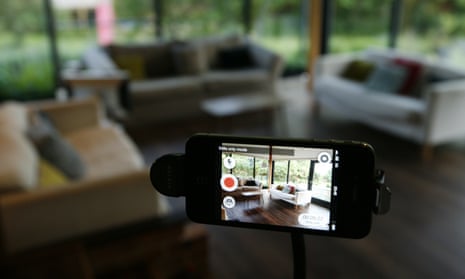If Jim Poss hadn’t dropped his phone in the bath while bathing his son, he might never have hit upon the idea for his business. While researching a cheap replacement for his waterlogged iPhone, he had an epiphany: the used phones sold online for $60 (£45) or less could be repurposed as Internet of Things sensors and used to form flexible, low-cost security and vehicle telematics systems.
That idea quickly evolved into Modifi, a remote sensing platform that can capture everything from travel statistics to criminals. “There are around one billion idle smartphones in America,” says Poss, who also founded Big Belly Solar, which makes smart solar-powered trash compactors. “They’re just sitting in drawers at the moment destined for landfill. Yet they’ve got a GPS, two cameras, a microphone, a processor and five or six other useful sensors.”
Modifi works by converting used phones into low-cost sensor systems for use in security, fleet management and home monitoring. Users can create customised sensor alerts and mount the repurposed phones, which Modifi calls Mods, on a variety of surfaces – including doors, dashboards, walls and windows.
Mods can detect light, sound, movement, magnetic fields and power outages. If movement is detected in a retail store after a certain hour, for instance, the Mod can automatically start recording video and alert the owner of the building via a text message.
The company is currently working with three clients, which between them manage 8.1m “end-points” (networked devices). In the US, Poss estimates that Modifi’s systems could eventually account for over 110m end-points, “a seemingly large number until you recognise that this is only about 10% of the smartphones left idle or trashed annually”.

Poss is hopeful that manufacturers and carriers begin to transition from an equipment-based economic model to a service-based one. “Instead of solving a thousand different problems with a thousand different devices, we’re taking this one hugely versatile smart device and giving people the opportunity to configure it as they want,” says Poss.
Although legislation imposes recovery and recycling targets on the EU IT and electronics industry, with penalties for companies who fail to comply, e-waste is still one of the fastest growing waste streams in the world. According to the UN environment programme, 41m tonnes of e-waste was produced in 2014. Up to 90% was illegally dumped or exported to developing countries where devices are often improperly dismantled, causing health problems for workers and local communities.
Trade-in schemes run by phone manufacturers and carriers allow people to claw back some value from their old device; the higher-value handsets are refurbished and resold, while those of little market value are recycled. But globally only 12% of smartphone upgrades involve older devices being sold or traded for a new one. The Green Alliance estimates that up to 125m smartphones (pdf) are languishing in UK householder’s lofts, drawers and cupboards.
Modifi is just one of a number of organisations aiming to tackle this growing e-waste problem by repurposing unwanted smartphones. UK- and US-based company Manything has created a free app to repurpose old phones as wireless security cameras for home use.
Joanna Santander, head of business development for Manything, says it wanted to provide an ever-improving video monitoring solution without requiring customers to invest in new hardware. “Even if you’ve got an old iPhone 3GS with a cracked screen that’s never going to be worth selling, you can still put that to good use as a Manything camera,” she explains.
Manything has more than 500,000 registered users, and more than 15 years worth of video sessions are securely recorded every day – just under a quarter of YouTube’s daily video upload rate of 66 years per day. Several burglaries have been thwarted, according to the company. However conversations with smartphone manufacturers haven’t been forthcoming, says Santander.
The array of potential uses for unwanted phones is still being explored. Phonvert, an open-source project started by students at Keio University and Tokyo University in Japan, began when the students developed code to reuse the sensors on old smartphones, which attracted the interest of a couple of investors. “We were trying to start a business, but along the way we realised that both we and the world would benefit more if we made the project open-source,” says Tomo Kihara, one of the students working on Phonvert.
Currently, the team is focused on building a community around the idea and encouraging them to come up with new applications for repurposed phones. More than 300 ideas from around the world have already been put forward, often reflecting needs specific to each country. “For example, in countries like Finland where the ageing population is a problem, an idea to detect whether an elderly people had fallen was popular. While in developing countries around South Asia there were ideas for phonverting for education – ie to use retired smartphones as textbooks for children, since books are often very expensive.”

Comments (…)
Sign in or create your Guardian account to join the discussion